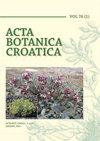Allelopathic potential of Ficusretusa L. leaf litter on understory vegetation in urban gardens
IF 0.7
4区 生物学
Q3 PLANT SCIENCES
引用次数: 3
Abstract
– Pruning Ficus trees in urban green spaces may lead to the accumulation and spread of their leaf litter on the understory vegetation. This study was conducted to evaluate the allelopathic effect of Ficus retusa L. leaf litter on the understory species in urban gardens. A field study showed that the plant cover and species richness of litter-affected plots were lower than those of litter-free areas. The litter-affected soils had substantially lower pH and higher electrical conductivity. In a greenhouse experiment, litter-affected soil significantly inhibited the emergence and growth of understory species selected for the purpose of this study: Melilotus indicus (L.) All. , Trifolium resupinatum L. and Amaranthus viridis L. Osmotic potentials equivalent to those of the litter-affected soils did not affect emergence or growth of these species. A spectrophotometric analysis indicated that the litter-affected soils contained larger amounts of phenolics and flavonoids. An HPLC analysis revealed that the litter-affected soils contained higher concentrations of free phenolic and flavonoid allelochemicals. These results demonstrate that F . retusa leaf litter may reduce plant cover and species richness. The significant inhibition in both field and greenhouse experiments could be attributed to phenolic and flavonoid allelochemicals released from the tree litter, as the osmotic potential of the litter had no effect on the understory species. The allelopathic potential of F. retusa leaf litter plays at least a partial role in reducing urban vegetation.榕树落叶对城市园林林下植被的化感潜力
–修剪城市绿地中的榕树可能会导致其落叶在林下植被上堆积和扩散。本研究旨在评价榕树落叶对城市园林下层植物的化感作用。一项实地研究表明,受凋落物影响的地块的植物覆盖率和物种丰富度低于无凋落物地区。受枯枝落叶影响的土壤具有明显较低的pH值和较高的电导率。在温室实验中,受枯枝落叶影响的土壤显著抑制了为本研究目的选择的林下物种的出现和生长:Melilotus indicus(L.)All,Trifolium resupinatum L.和Amaranthus viridis L.的渗透势与受枯枝落叶影响的土壤的渗透势相当,但不影响这些物种的出现或生长。分光光度分析表明,受枯枝落叶影响的土壤中含有大量的酚类和黄酮类化合物。高效液相色谱分析表明,受枯枝落叶影响的土壤中含有较高浓度的游离酚类和类黄酮化感物质。这些结果表明。枯枝落叶可能降低植物覆盖率和物种丰富度。田间和温室实验中的显著抑制作用可归因于落叶层释放的酚类和黄酮类化感物质,因为落叶层的渗透势对林下物种没有影响。枯枝落叶的化感潜力至少在减少城市植被方面发挥了部分作用。
本文章由计算机程序翻译,如有差异,请以英文原文为准。
求助全文
约1分钟内获得全文
求助全文
来源期刊

Acta Botanica Croatica
PLANT SCIENCES-
CiteScore
2.50
自引率
0.00%
发文量
34
审稿时长
>12 weeks
期刊介绍:
The interest of the journal is field (terrestrial and aquatic) and experimental botany (including microorganisms, plant viruses, bacteria, unicellular algae), from subcellular level to ecosystems. The attention of the Journal is aimed to the research of karstic areas of the southern Europe, karstic waters and the Adriatic Sea (Mediterranean).
 求助内容:
求助内容: 应助结果提醒方式:
应助结果提醒方式:


